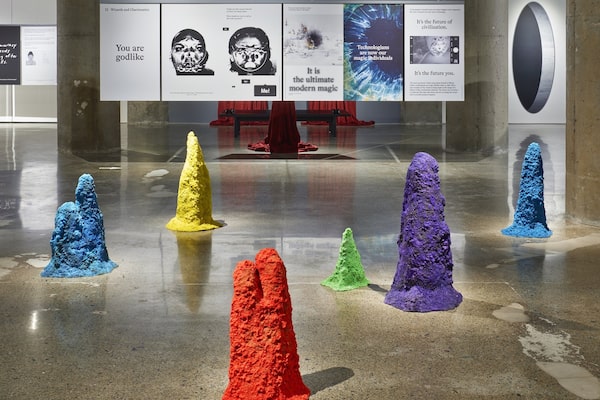
Agnieszka Kurant's A.A.I.Tom Arban/Handout
Do you expect to live until 79 … or 83 … or 102? Maybe the real question should be: Who wants to know?
You can take a life expectancy quiz in the lobby of the Museum of Contemporary Art Toronto these days. The results will be displayed on a colourful pixelated screen for you – and anybody else in the vicinity – to consider. The quiz, an artistic project by Canadian tech executive Dennis Kavelman, neatly captures our odd relationship with media and technology. As it flatters the participant with its clever confusion of particularity and individuality, and then offers the personal information it has mined for public display, it is both irresistible and a bit creepy.
So welcome to the age of you, or Age of You, an exhibition about the contemporary state of selfhood. The show is based on a forthcoming book by two international writer/art curators, Shumon Basar and Hans Ulrich Obrist, and the Canadian novelist, artist and designer Douglas Coupland of Generation X fame, and it follows the trio’s 2015 title The Age of Earthquakes: A Guide to the Extreme Present.
Rather surprisingly for a project about social changes caused by new technology, the exhibition attempts to reproduce the linear experience of the proposed book, page after page, in another of MOCA’s determined efforts to make cultural theories concrete and accessible. So, you can follow a sequential route carefully marked on the floor of the museum’s second- and third-floor galleries through Chapters 1 to 13 … or just wander among these large text-and-photography panels at will. Either way, you will quickly grasp the Couplandesque thesis: Digital technology and social media are transforming the way we experience our consciousness, leading to what the writers call the extreme self.

Satoshi Fujiwara's Crowd Landscape.tom Arban
Despite its name, the extreme self is a condition that suggests a loss of individuality in an era when people do not feel they exist if they are not narrating that existence on social media. As the bar for individuality is set higher and higher, more and more of us will fail to clear it. Age of You notes that millions of Chinese bachelors are convinced by clever chatbots that they are communicating with real girlfriends, in a country where men outnumber women 113.5 to 100, while the Silicon Valley billionaires who have crafted the future are now planning postapocalyptic escapes to New Zealand … or Mars. Meanwhile, consensus-based reality is breaking down in the face of internet conspiracy theories about everything from vaccination to school shootings.
There is loads of truth in Age of You’s insights and, as it suggests that only those over 40 have comfortably experienced classic individuality, it may offer the middle-aged many “Aha!” moments. All this would explain, for example, why young Instagrammers have been earnestly promising each other that in the future they are going to enjoy holidays rather than living them as a series of photo shoots, leaving the seniors to puzzle over the need for either the posing or the pledge to stop it.
But there’s also loads of overstatement and generalization in a text purposefully delivered in snippets that can be grasped as quickly as social-media posts. Coupland, Basar and Obrist do love their epigrams, starting with “The 20th century was about what belongs to who. The 21st century is about who belongs to what,” and continuing with “Can young people ever have nostalgia if they only ever inhabit a present?” or “Right now, anxiety is to Generation Y what depression was to Generation X.” It’s not that you are going to disagree with these bold statements, it’s just that, well before Chapter 13, you may feel so hopelessly and depressively overwhelmed that you can barely peep out any counter examples. “Didn’t recent climate protests show that many millennials have a completely traditional understanding of individual responsibility?” you may find yourself muttering belatedly as you head for the exit.

Sophia Al Maria's Mirror Cookie.Tom Arban
Thank goodness that Age of You is also an art exhibition of multimedia work by international artists that allows you stop and consider these issues in a more contemplative mode, offering exactly the kind of slower experience of which the extreme self, the curators argue, is increasingly incapable. Satoshi Fujiwara has contributed an unsettling portrait of the crowd on a heroic scale, in the form of a giant photographic banner twisted around two columns in the centre of the exhibition space. One side features a mash-up of intense faces rendered in high contrast and saturated tones; the other closes in on a multitude of enlarged facial parts – eyes, beards, cheeks. Meanwhile, Yuri Pattison has made wallpaper covered in the different eye emojis used by various social media platforms and aps, surrounding the viewer with a cheeky metaphor for dubious emotions and perpetual surveillance. These are works that let you question the changing relationship between the individual and the group in a less didactic environment.
On the subject of our relationship with automation, the London fashion designer Craig Green is represented by a marketing video for his latest designs: They feature brightly coloured, flag-like clothing inspired by kites and sails, and modelled not by people but by robots whose stick bodies are powered by hydraulic movements. And Agnieszka Kurant creates a metaphor for crowdsourcing with sculptures of coloured sand that have been built for her by termite colonies. Both bodies of work provide eerie experiences that evoke the softening of the barrier between humanity and technology, yet also create colourful delight. Perhaps if the viewer just reads the Age of You “book” as a rather grandiose curatorial statement, there’s room here to consider a dozen contemporary art works in that context, but on their own merits.
One of the most compelling contributions is by Stéphanie Saadé: Digiprint is an oversized digital photograph that might appear, at first glance, to be one giant black-and-grey abstraction. It is actually an image of an unilluminated smartphone screen covered in thumb- and fingerprints. Enlarged to statuesque proportions as if to reflect the phone’s importance in a life, the image captures both the persistent technology and the fleeting mark of the user, turning the familiar into the strange. It is a thing of paradoxical beauty which, like many a successful art object, operates in a realm beyond words.
Age of You continues at the Museum of Contemporary Art Toronto until Jan. 5, 2020.
Live your best. We have a daily Life & Arts newsletter, providing you with our latest stories on health, travel, food and culture. Sign up today.
 Kate Taylor
Kate Taylor